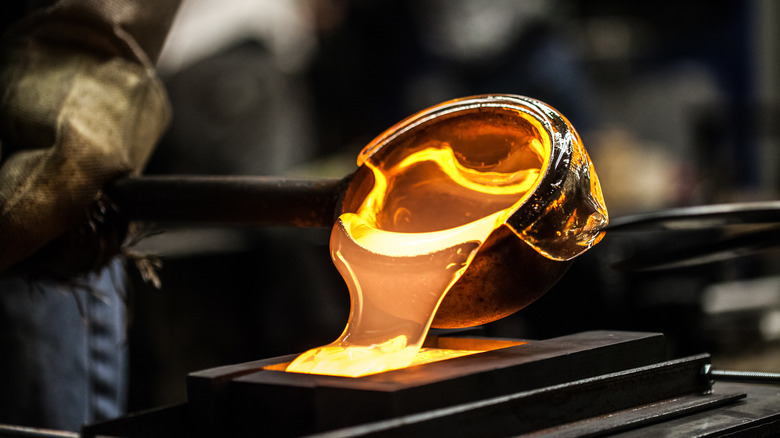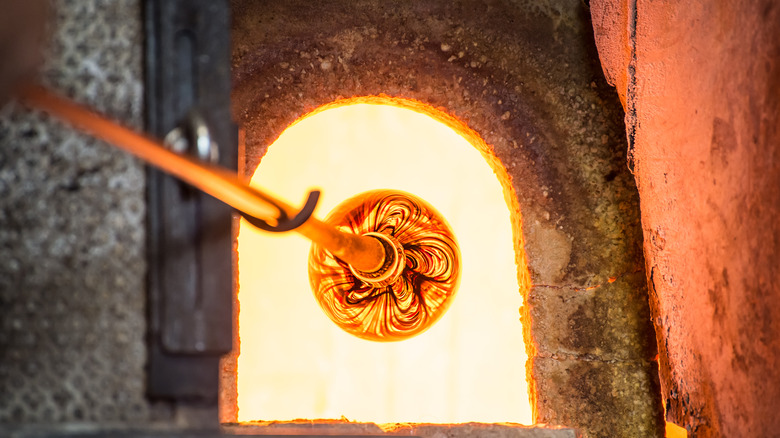Why Glass Still Remains A Mystery To Physicists
There's a scene in the movie "Sweet Home Alabama" in which one of the characters talks about how glass is made. He talks about waiting for lightning to hit the sand on a beach and harvesting the glass left behind.
It sounds like something made up for a movie, but it's not, per Discovery. It's just one of the many ways that glass remains a mystery to so many people. It's not just "lightning glass" that fascinates scientists; it's the entire process that still mystifies them.
That's right: People of science don't know everything there is to understand about how glass becomes, well, glass. In particular, they're curious about the glass phase, that point where the glass becomes solid but without a discernible crystalline structure. You see, to be a solid, something has to have form. According to the Eindhoven University of Technology, physicists can't explain why and how it goes from a liquid to the glass phase. And they believe that once they learn about the process, it can have wide-reaching industrial uses.
First, what is glass in the first place? Glass and ceramics maker Corning wrote that glass is essentially sand that's been melted down and then chemically transformed. The sand needs to be made up of mainly silica. When the sand gets hot enough, it becomes liquid, which can then be formed in molds or canes when it cools. And when you add materials to it, it can change colors or structure.
Both a liquid and a solid?
Scientists often debate if glass is liquid or solid. Physics Today noted that since glassy materials lack a crystalline structure, they share properties with liquids, whose molecules are all jumbled about. But because glass doesn't deform easily (at least when it's not super melted) it's technically considered something solid. This is why some people refer to glass as a supercooled liquid.
When silica is heated to start the glass-making process, its atoms begin to move very fast. As it cools down, its particles stop moving all over the place and then settle in a recognizable pattern. This is not the case with glass. In many cases, glass represents states of matter that are not in equilibrium.
That's not the only mystery. The Eindhoven University of Technology said scientists also study the viscosity, or the ease in which something flows and deforms of materials. Of course, when something is liquid, and its atoms are all in disarray, like water, it freely flows. But with glass, its viscosity becomes almost 15 times more than something liquid. And yet, its atoms remain the same.
Like any great detective, scientists want to solve the mystery of why glass has properties of both a solid and a liquid. One such researcher trying to understand more about this material is Liesbeth Janssen. She began working to find out exactly why glass behaves this way and hopefully even develop a theory that explains why the viscosity of glass grows so quickly during the glass phase and yet remains a liquid.
It's not impossible
Janssen is still trying to figure out what makes glass tick, and she's determined to find out even if her doctoral adviser told her she's trying to do the impossible. So far, she was able to come up with a theory that aims to predict how fast materials change from a liquid to an amorphous solid like glass but only for one type of particle. Janssen and her team still have to come up with an equation for multiple particles.
So what does it matter if scientists finally solve the mystery of glass? Janssen believes that a better understanding of how materials like glass develop might mean we can apply the same methods to other things. For example, it can unlock fully recyclable plastic where the quality doesn't deteriorate when used again.
Cells in the human body also have a glass phase, but humans are not made of glass. Asthma patients have epithelial cells that move quickly, while cancerous tumors go through a glass phase when they begin to metastasize and move to other parts of the body. Understanding the glass phase is key to developing ways to treat asthma or cancer.
That's not the only glass-related research going on. Science Daily reported researchers found a new liquid phase within the glassification process that can make denser materials. These can be used to create thin but incredibly strong glass for electronic devices. Who knew glass wasn't as crystal clear as we thought?


